Fire Characteristics of Selected Tropical Woods without and with Fire Retardant
Abstract
1. Introduction
2. Materials and Methods
2.1. Materials
2.2. Methods
2.2.1. Test Equipment
2.2.2. Measurement Procedure
3. Results
4. Discussion
5. Conclusions
Author Contributions
Funding
Conflicts of Interest
References
- Momoh, M.; Horrocks, A.R.; Eboatu, A.N.; Kolawole, E.G. Flammability of tropical woods—I. Investigation of the burning parameters. Polym. Degrad. Stab. 1996, 54, 403–411. [Google Scholar] [CrossRef]
- Elvira-Leon, J.C.; Chimenos, J.M.; Isabal, C.; Monton, J.; Formosa, J.; Haurie, L. Epsomite as flame retardant treatment for wood: Preliminary study. Constr. Build. Mater. 2016, 126, 936–942. [Google Scholar] [CrossRef]
- Cekovska, H.; Gaff, M.; Osvald, A.; Kacik, F.; Kubs, J.; Kaplan, L. Fire resistance of thermally modified spruce wood. BioResources 2017, 12, 947–959. [Google Scholar] [CrossRef]
- Koklukaya, O.; Carosio, F.; Grunlan, J.C.; Wagberg, L. Flame-retardant paper from wood fibers functionalized via layer-by-layer assembly. ACS Appl. Mater. Interfaces 2015, 7, 23750–23759. [Google Scholar] [CrossRef] [PubMed]
- Östman, B.A.-L. Fire performance of wood products and timber structure. Int. Wood Prod. J. 2017, 8, 74–79. [Google Scholar] [CrossRef]
- Jiang, J.; Li, J.; Hu, J.; Fan, F. Effect of nitrogen phosphorus flame retardants on thermal degradation of wood. Constr. Build. Mater. 2010, 24, 2633–2637. [Google Scholar] [CrossRef]
- Ecochard, Y.; Decostanzi, M.; Negrell, C.; Sonnier, R.; Caillol, S. Cardanol and eugenol based flame retardant epoxy monomers for thermostable networks. Molecules 2019, 24, 1818. [Google Scholar] [CrossRef] [PubMed]
- Maqsood, M.; Langensiepen, F.; Seide, G. The efficiency of biobased carbonization agent and intumescent flame retardant on flame retardancy of biopolymer composites and investigation of their melt-spinnability. Molecules 2019, 24, 1513. [Google Scholar] [CrossRef] [PubMed]
- Sonnier, R.; Dumazert, L.; Livi, S.; Nguyen, T.K.L.; Duchet-Rumeau, J.; Vahabi, H.; Laheurte, P. Flame retardancy of phosphorus-containing ionic liquid based epoxy networks. Polym. Degrad. Stab. 2016, 134, 186–193. [Google Scholar] [CrossRef]
- Sonnier, R.; Otazaghine, B.; Ferry, L.; Lopez-Cuesta, J.M. Study of the combustion effiency of polymers using a pyrolysis-combustion flow calorimeter. Combust. Flame 2013, 160, 2182–2193. [Google Scholar] [CrossRef]
- Xu, Q.; Chen, L.; Harries, K.A.; Zhang, F.; Liu, Q.; Feng, J. Combustion and charring properties of five common constructional wood species from cone calorimeter tests. Constr. Build. Mater. 2015, 96, 416–427. [Google Scholar] [CrossRef]
- Giraldo, M.P.; Haurie, L.; Sotomayor, J.; Lacasta, A.M.; Monton, J.; Palumbo, M.; Nazzaro, A. Characterization of the fire behaviour of tropical wood species for use in the construction industry. In Proceedings of the WCTE 2016: World Conference on Timber Engineering, Vienna, Austria, 22–25 August 2016; Technischen Universität Graz: Graz, Austria; pp. 5387–5395. [Google Scholar]
- Gerad, J.; Guibal, D.; Paradis, S.; Cerre, J.C. Tropical Timber Atlas Technological Characteristics and Uses, 1st ed.; Editions Quæ: Versailles Cedex, France, 2017; pp. 600–602. [Google Scholar]
- Wiemann, M.C. Characteristics and availability of commercially important woods. In Wood Handbook: Wood as an Engineering Material; Forest Products: Madison, WI, USA, 2010; pp. 2.1–2.45. [Google Scholar]
- Cumaru—Specification Sheet. Available online: https://www.dlhwood.sk/wp-content/uploads/2017/01/60510_Tech_list_Cumaru_kor0.pdf (accessed on 13 November 2019).
- Garapa—Specification Sheet. Available online: https://www.dlhwood.sk/wp-content/uploads/2017/01/60510_Tech_list_Garapa_kor0.pdf (accessed on 13 November 2019).
- Ipe—Specification Sheet. Available online: https://www.dlhwood.sk/wp-content/uploads/2017/01/60510_Tech_list_Ipe_kor0-1.pdf (accessed on 13 November 2019).
- Kempas—Spectification Sheet. Available online: https://www.dlhwood.sk/wp-content/uploads/2017/01/60510_Tech_list_Kempas_kor0.pdf (accessed on 13 November 2019).
- Merbau—Specification Sheet. Available online: https://www.dlhwood.sk/wp-content/uploads/2017/01/60510_Tech_list_Merbau_kor0-1.pdf (accessed on 13 November 2019).
- ASTM E1354-17 Standard Test Method for Heat and Visible Smoke Release Rates for Materials and Products Using an Oxygen Consumption Calorimeter; ASTM International: West Conshohocken, PA, USA, 2017. [CrossRef]
- Cone Calorimeter. Available online: http://polymer.sav.sk/old/index.php (accessed on 22 December 2019).
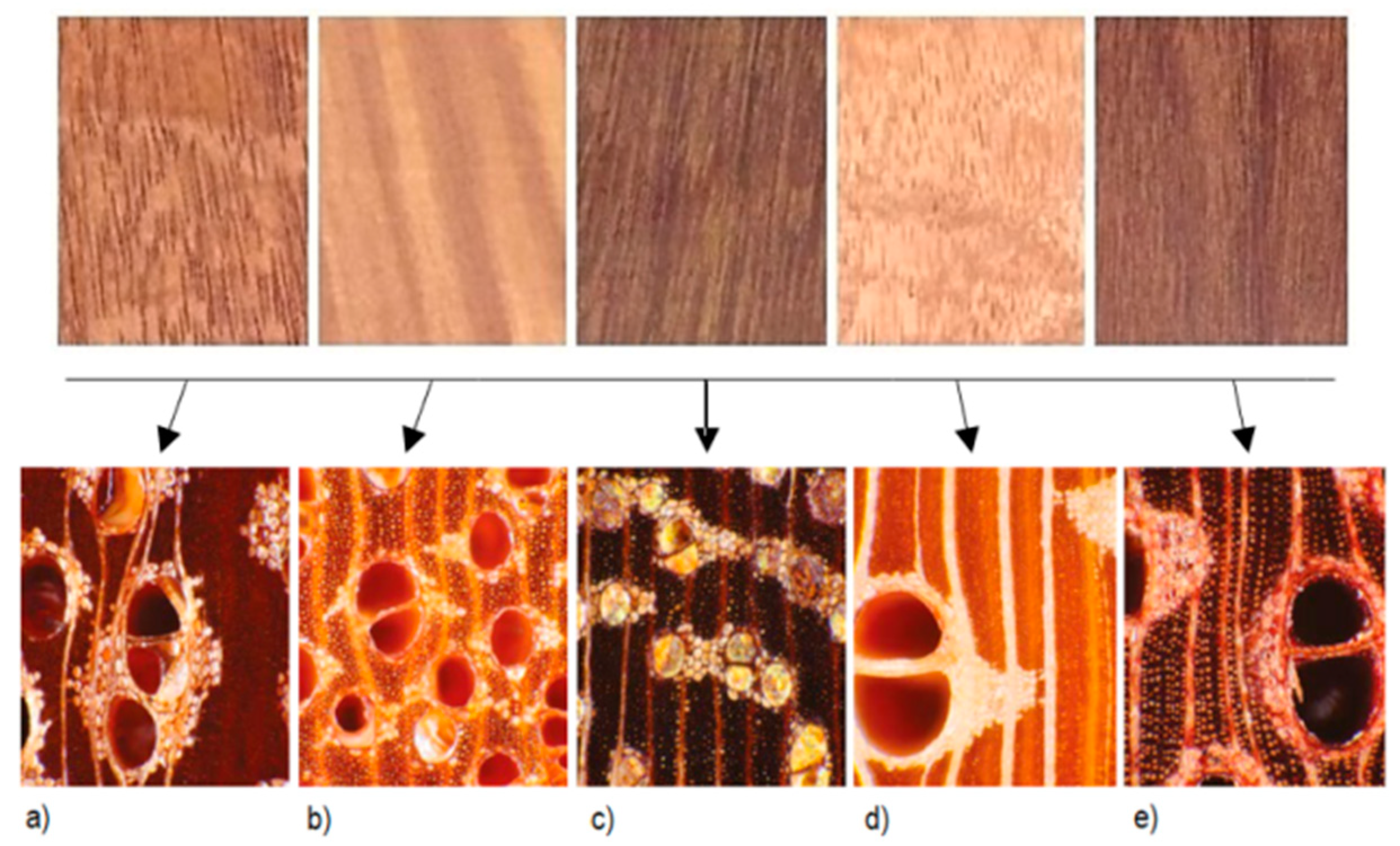



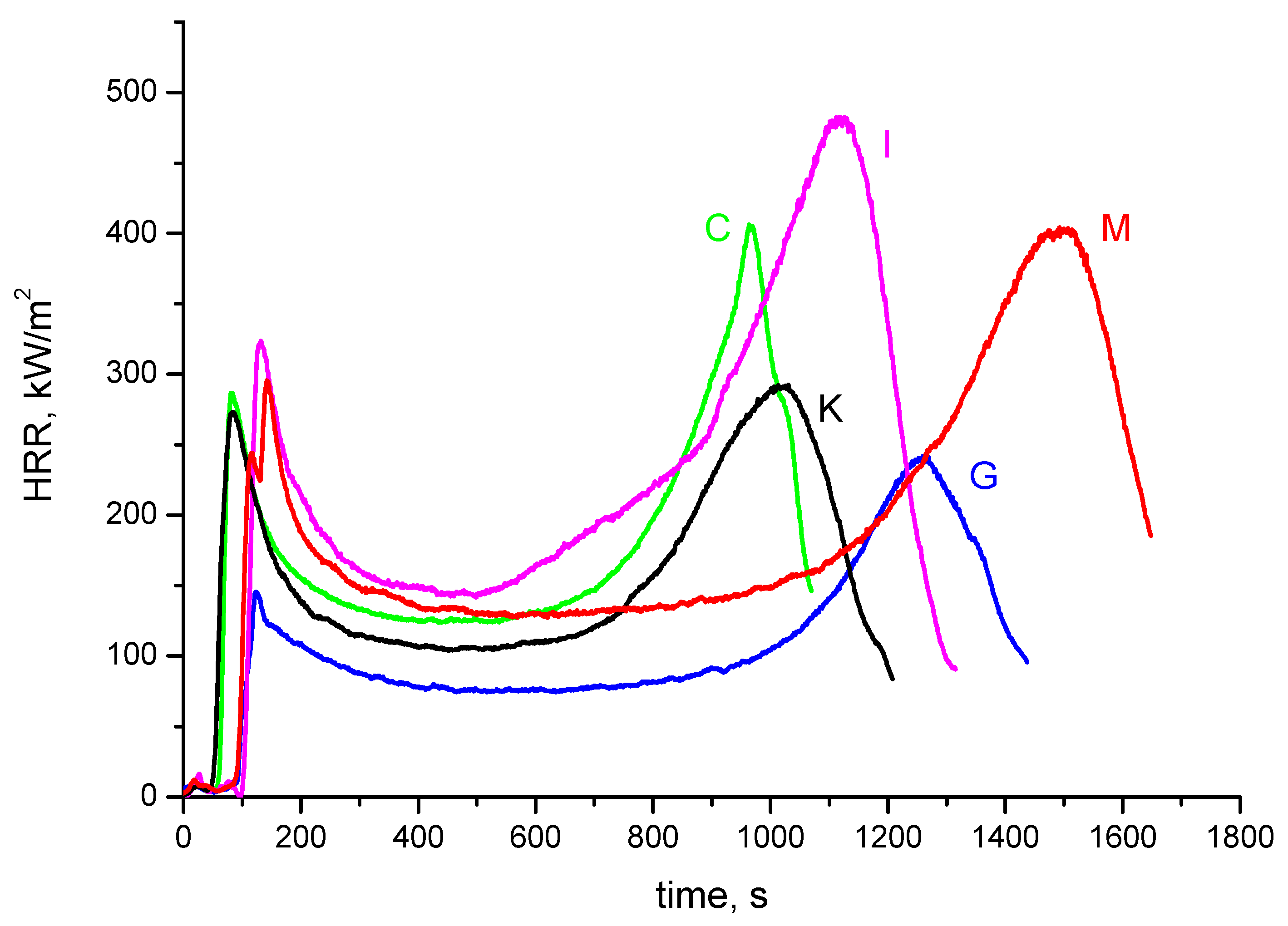

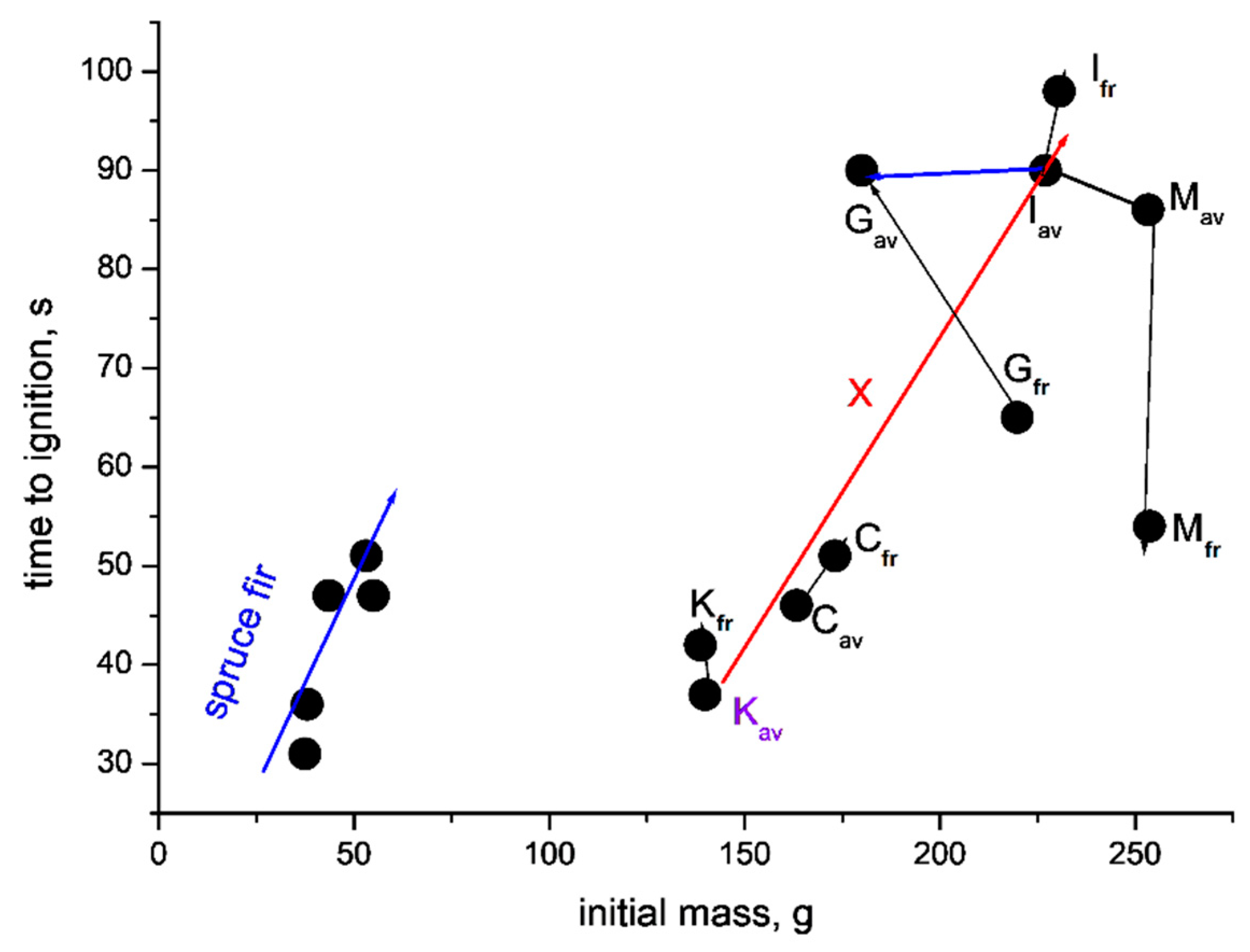
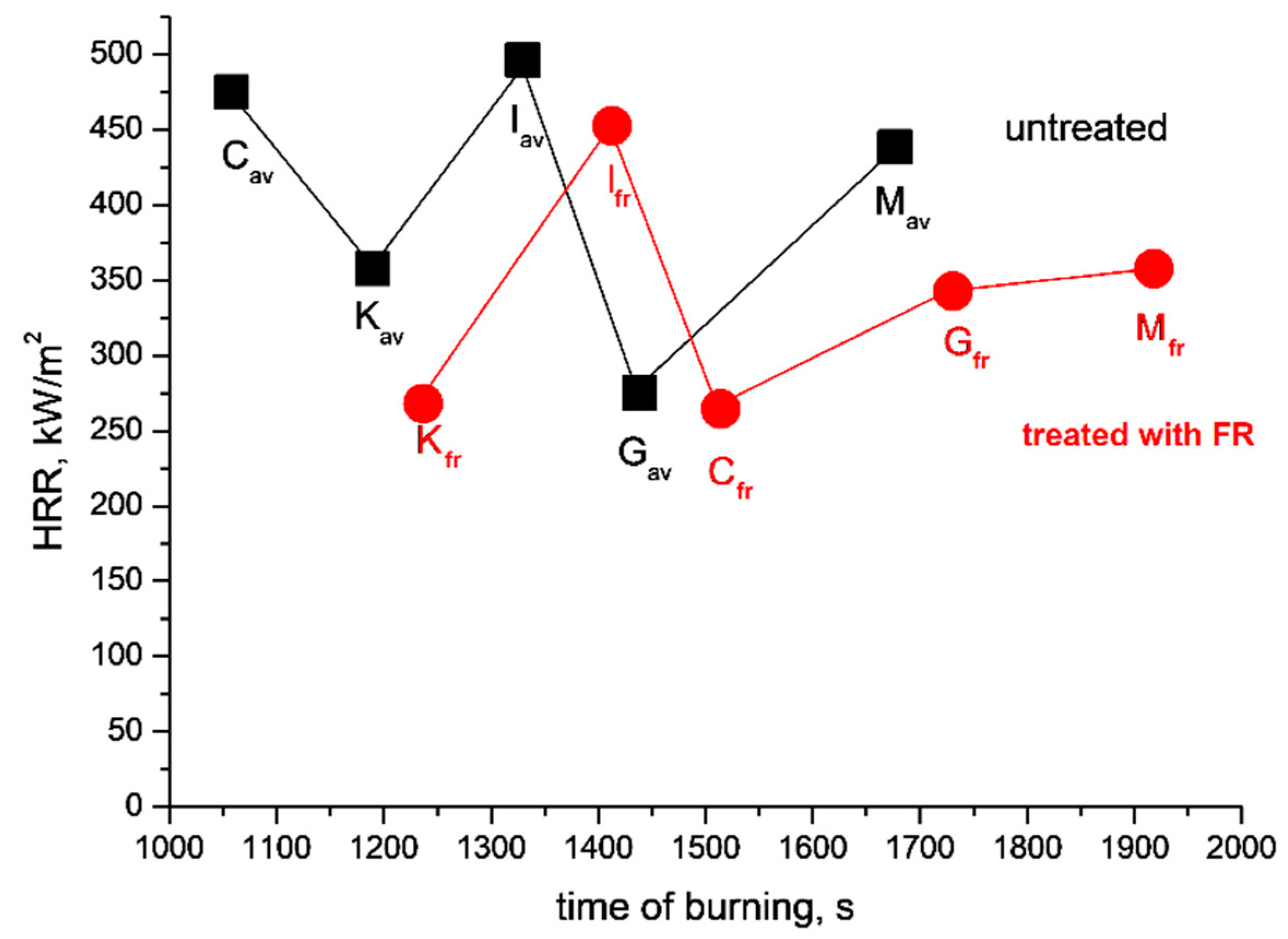


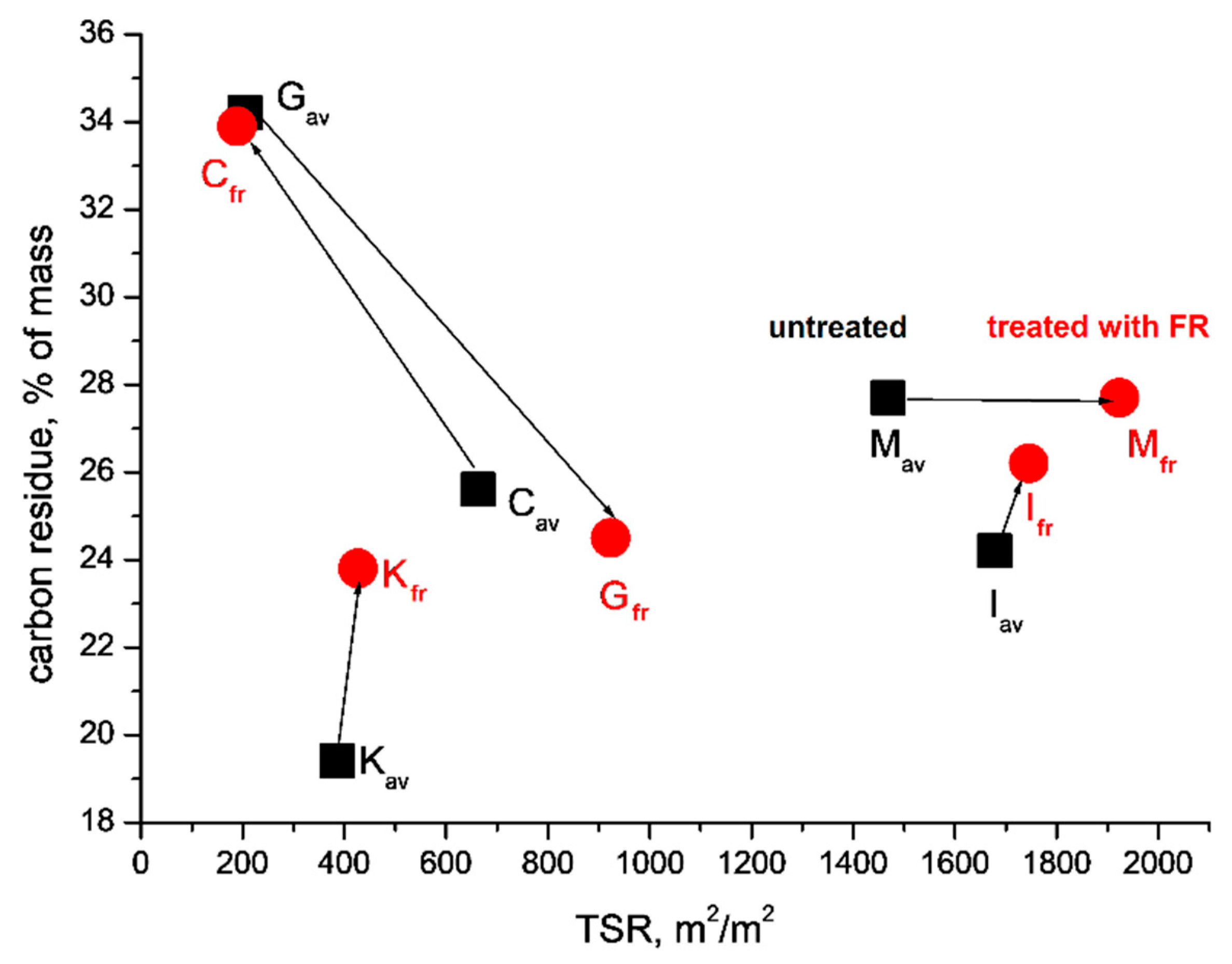
| Name |
|---|
| FeHPO4 |
| Citric acid |
| Polyoxyethylene stearyl alcohol |
| Water |
| The Sample | Density 1 (kg/m3) | Density 2 (kg/m3) |
|---|---|---|
| Cumaru | 1200 | 1070 |
| Garapa | 1050 | 790 |
| Ipe | 1300 | 1050 |
| Kempas | 1050 | 880 |
| The Sample | Cumaru | Garapa | Ipe | Kempas | Merbau |
|---|---|---|---|---|---|
| The acceptance (g) | 2.4 | 2.5 | 6.5 | 8.4 | 2.6 |
| Sample | Parameters | ||||||||
|---|---|---|---|---|---|---|---|---|---|
| m (g) | mlost (g) | Time to Ignition/Time of Burning (s) | EHC (MJ/kg) | Peak HRR (kW/m2) | TOC (g) | TSR (m2/m2) | MARHE (kW/m2) | % of Carbon Residue | |
| Cav | 163.3 | 121.5 | 45 ± 4/1067 ± 30 | 15.6 | 457.2 ± 42.3 | 115.9 | 662.2 | 176.5 ± 5.1 | 25.5 ± 0.3 |
| Cfr | 173.2 | 114.4 | 51/1514 | 13.4 | 264.4 | 93.5 | 189.0 | 98.1 | 33.9 |
| Gav | 180.0 | 118.5 | 90 ± 10/1439 ± 49 | 13.6 | 275.0 ± 28.2 | 98.4 | 205.7 | 107.4 ± 6.3 | 34.2 ± 0.5 |
| Gfr | 189.8 | 166.0 | 65/1731 | 15.9 | 342.5 | 161.0 | 923.0 | 148.6 | 24.5 |
| Kav | 139.9 | 112.7 | 37 ± 2/1200 ± 34 | 17.1 | 307.8 ± 9.8 | 115.8 | 385.8 | 155.6 ± 7.4 | 20.6 ± 1.7 |
| Kfr | 138.7 | 105.7 | 42/1237 | 17.5 | 268.1 | 112.8 | 426.8 | 145.0 | 23.8 |
| Mav | 253.3 | 183.0 | 91 ± 16/1676 ± 50 | 17.4 | 438.4 ± 32.8 | 194.8 | 1468.8 | 187.9 ± 8.4 | 27.7 ± 1.2 |
| Mfr | 253.7 | 183.4 | 54/1565 | 17.1 | 357.6 | 191.6 | 1924.1 | 170.1 | 27.7 |
| Iav | 227.0 | 171.9 | 89 ± 5/1340+-64 | 16.9 | 500.9 ± 17.9 | 177.6 | 1678.8 | 224.6 ± 8.6 | 24.4 ± 0.4 |
| Ifr | 230.6 | 170.2 | 98/1413 | 15.8 | 452.6 | 164.7 | 1745.9 | 187.8 | 26.2 |
| Sample | Some Parameters from Cone Calorimeter after the Burning of Selected Samples | ||||||
|---|---|---|---|---|---|---|---|
| Density (kg/m3) | Initial Mass (g) | Time to Ignition (s) | EHC (MJ/kg) | TOC (g) | Peak HRR (kW/m2) | Carbon Residue (%) | |
| Spruce Fir | 561 | 55.02 | 47 | 15.2 | 41.6 | 227.0 | 17.2 |
| 553 | 53.17 | 51 | 14.3 | 37.2 | 232.7 | 17.9 | |
| 445 | 43.64 | 47 | 14.4 | 31.7 | 234.9 | 15.1 | |
| 458 | 44.45 | 41 | 14.4 | 32.5 | 218.5 | – | |
| 385 | 37.37 | 31 | 15.3 | 30.1 | 224.2 | 12.6 | |
| 392 | 38.06 | 36 | 15.3 | 29.9 | 241.0 | 13.9 | |
© 2020 by the authors. Licensee MDPI, Basel, Switzerland. This article is an open access article distributed under the terms and conditions of the Creative Commons Attribution (CC BY) license (http://creativecommons.org/licenses/by/4.0/).
Share and Cite
Makovicka Osvaldova, L.; Kadlicova, P.; Rychly, J. Fire Characteristics of Selected Tropical Woods without and with Fire Retardant. Coatings 2020, 10, 527. https://doi.org/10.3390/coatings10060527
Makovicka Osvaldova L, Kadlicova P, Rychly J. Fire Characteristics of Selected Tropical Woods without and with Fire Retardant. Coatings. 2020; 10(6):527. https://doi.org/10.3390/coatings10060527
Chicago/Turabian StyleMakovicka Osvaldova, Linda, Patricia Kadlicova, and Jozef Rychly. 2020. "Fire Characteristics of Selected Tropical Woods without and with Fire Retardant" Coatings 10, no. 6: 527. https://doi.org/10.3390/coatings10060527
APA StyleMakovicka Osvaldova, L., Kadlicova, P., & Rychly, J. (2020). Fire Characteristics of Selected Tropical Woods without and with Fire Retardant. Coatings, 10(6), 527. https://doi.org/10.3390/coatings10060527






